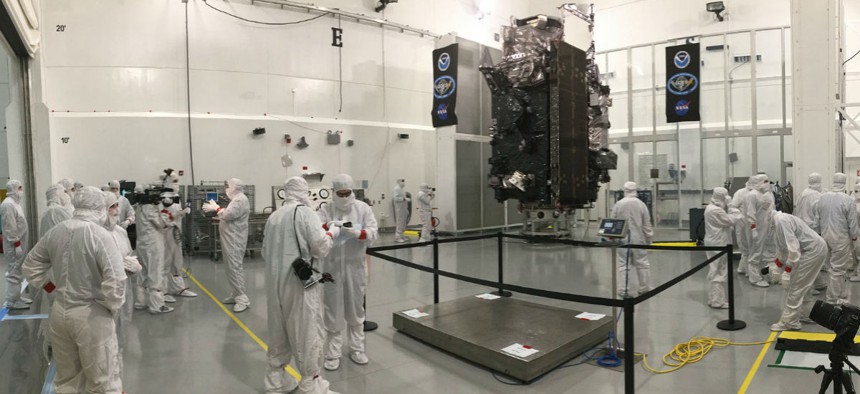
Media viewed the GOES-R weather satellite at Astrotech in Titusville, Florida, in September. The launch has been delayed until Spring 2017. NOAA photo
NOAA Rebuts Famed Critic of National Weather Service
University meteorologist calls agency equipment and models obsolete.
A key program chief at the National Oceanic and Atmospheric Administration took to the pages of Sunday’s New York Times Magazine to rebut a long-standing barrage of criticism from a University of Washington meteorologist.
The original Oct. 17 article, titled “Why Isn’t the U.S. Better at Predicting Extreme Weather?” by Michael Behar, described critic Cliff Mass’ deconstruction of the National Weather Service’s “bungled predictions” for when two recent hurricanes would make landfall.
“Mass argues that these models are significantly flawed in comparison with commercial and European alternatives,” the reporter wrote. “American forecasting also does poorly at data assimilation, the process of integrating information about atmospheric conditions into modeling programs; in the meantime, a lack of available computing power precludes the use of more advanced systems already operating at places like the European Center for Medium-Range Weather Forecasts, based in Reading, England,” the piece said. “And there are persistent management challenges, perhaps best represented by the legions of NOAA scientists whose innovations remain stranded in research labs and out of the hands of the National Weather Service operational forecasters who make the day-to-day predictions in 122 regional offices around the country.”
The article portrayed William Lapenta, who heads NOAA’s subgroup called the National Centers for Environmental Prediction, as grateful to Mass for criticism that gets weather forecasting on popular TV shows and pressures Congress to increase funding for supercomputers. “His job through his blog is quite honestly to provoke people to respond and hopefully take action,” Lapenta told the reporter.
But his tune changed once the full article was published claiming that “Hurricanes like Matthew have laid bare the dirty secret of the National Weather Service: its technologies and methods are woefully behind the times.”
Behar’s article “provides a stale narrative about the state of American weather forecasting,” he wrote in a letter published Nov. 6. “He ignores the major investment and effort underway to tackle these challenges. The National Weather Service is in the midst of a technology revolution, bringing new satellites, supercomputers and upgraded models online to provide forecasts and warnings that are among the most accurate in the world.”
Last week, however, Nextgov reported that NOAA has again postponed the launch of the first satellite in the $10 billion Joint Polar Satellite System by another four to six months because of ongoing issues with onboard instrumentation and problems with ground systems.
The decision came after a NOAA-convened Independent Integration Team conducted a risk-based evaluation of cost, schedule and performance issues for JPSS-1.
As Nextgov’s Frank Konkel reported: “Another delay further increases the risk of a gap in weather data vital to U.S. weather forecast, which could significantly impact their accuracy. The Government Accountability Office took the unusual step of adding NOAA’s environmental satellite programs on its biennial High-Risk List in 2013, and recently Congress has become increasingly concerned, pushing NOAA to pursue commercial satellite operations where available.







